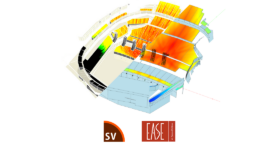Dunk's World
18 Feb 2021
Phil Spector and The ‘Wall-To-Wall’ of Sound***

Subscribe to CX E-News
In 1958, a few school friends crowded into Gold Star Recording Studios in Hollywood, coughed up the $40 for a two hour demo session, and recorded a song that one of them had written.
Their band called themselves The Teddy Bears, after Elvis’ current hit, and the song was called ‘To know him is to love him’, which ended up a # 1 hit, selling 1.4 million copies! It’s the stuff teen dreams are made of, and the plot of many a teen movie.
The songwriter was, of course, an 18-year-old Phil Spector, the legendary ’60s record producer who died recently from COVID-19 complications at the age of 81. He became famous for his ‘Wall of Sound’ production method.
People always talk about this when they describe his ‘sound’, but there is very little hard info on what that process was. Ask people about it and they glibly reply “Oh, lots of overdubs, echo and reverbs and stuff.”
Well, not really true. But, today’s your lucky day, because as a lifelong Phil Spector fan, ol’ Dunk has gathered together as much information as possible on his recording process.
So, since CX is a professional magazine, for professionals, let’s not focus on Phil’s private life, wives, or the fact he was an abusive convicted murderer. We’re going to concentrate on the nitty-gritty of getting the sound onto tape.
How did he get his sound? Let’s start with the studio. From the days of The Teddy Bears onwards he nearly always worked at Gold Star recording studios, on the corner of Santa Monica Boulevard and Vine Street. It was started by Dave Gold and Stan Ross in 1950, with Ross’ cousin, engineer Larry Levine joining them in 1952. It soon became known as a great demo studio. Good rates, great atmosphere and a creative vibe.
The studio equipment was pretty basic, even for those early days, and even more so by today’s standards. Still, as they say, ‘it ain’t what ya got it’s the way that ya use it!’
The tape recorder was an Ampex 350, a three-track machine, and by 1963 there was a 12 channel ‘big black knobs’ mixing console built by Dave Gold after hours at a friend’s workshop.
The console had limited EQ on each input channel — there was a low-end setting for 60Hz or 100Hz, and you could reduce that by 3dB or 6dB, or boost it by 3dB, 6dB or 9dB. Then, on the top end there was the choice of 3kHz, 5kHz and 10kHz, and you could increase those in 3dB steps up to 15dB.
Four-way quasi-parametric EQ it wasn’t – but it worked! Internally it had Bill Putnam’s United Audio amplifiers driving the Altec Model D3 monitors.
Effects consisted of the legendary Gold Star echo chambers. Dave Gold put a lot of work into designing those echo chambers – although today we would say they were really reverb chambers. They ran down the length of the main corridor in the building.
Trapezoidal in shape, with 2″ thick concrete walls and fed by an RCA 6203 ribbon mic, driving a 12″ speaker with a 10 Watt amplifier. These reverb chambers were so popular they were one of the main reasons for the success of the studio, and a primary contributor to the Wall of Sound.
Pictures of the monitor speakers in the live room look like a couple of big Altec horn loaded A7 cabinets, more normally seen in concert live sound reinforcement. Still, with 25 musicians playing in a relatively small room, I guess that’s what they needed to be heard.

The recording was mixed live to one of the three tracks on the Ampex, and sometimes doubled to the second track for more impact; the third track was usually left for the vocals.
It wasn’t recording as we know it today. No multi-tracking, just the sound of the relatively small live room and careful placement of the instrument microphones, which were a varied collection of RCA, Sony and EV dynamics or ribbons. And great musicians!
For the drum mics there would just be a Neumann U67 overhead and an RCA 77 on the kick drum. That was it!
On a typical Phil Spector session there would be one or two drummers, three or four bass players, three piano/Hammond/keyboard players, and four (at least) guitarists, including electric and acoustics. Every one of them was a leading musician in their own right and formed a loose-knit collective calling themselves ‘The Wrecking Crew’.
One of the secrets to the sound was quite literally hours of rehearsal. Phil was obsessive about getting the exact sound and ‘feel’ that he was after and would have the musicians run through every part of every track, phrase by phrase, beat by beat for a few hours until he was satisfied.
Often the session would be well into overtime before anything had actually been recorded to tape! Top guitarist Howard Roberts only lasted one session, and when his fingers started bleeding, went home and never came back!
Sessions started with the guitars until Phil was totally happy with the way they sounded, then the pianos/keys, then basses, and last of all the drums, with extra percussion supplied by anyone who happened to be lying around. Then all mixed to glorious Mono with a generous wash of reverb!
Phil often said that his aim was to make “little symphonies for the kids”; three minutes of musical escapism. As a youngster in the 60s I had never heard of Phil Spector, but I bought a lot of his 45s because I liked the sound
of them, especially Ronnie Ronette’s voice.
Hmm. Didn’t every teenage boy? Phil certainly did, and made her Mrs Spector as fast as possible. It didn’t go well.
The quintessential Wall of Sound recording would have to be 1963s ‘Be My Baby’ by The Ronettes. It had all of the above, and more. But, just as a picture tells a thousand words, so does a video show us in real-time. And luckily for us, there is a YouTube video of part of the recording session that we can watch and re-live.
Multiply the 15 minute clip by four or five hours and you get a feeling of how the session went. On and on.
This was the first real Wall of Sound mega hit, and for the next three years Phil Spector ruled the singles charts around the world. It seemed as though everything he produced turned to gold.
And then came ‘River Deep – Mountain High’. A truly outstanding performance by Tina Turner, and the pinnacle of the Wall of Sound recording style.
Phil offered Ike Turner (Tina’s husband) $20,000 to sign up with Phil’s label on one condition – that he never attended the recording sessions or went near the studio. Ike understood the deal straight away; from one obsessive control freak to another.
Unfortunately, the record sank without trace on the Billboard Hot 100 charts in America, never getting higher than # 88 after four weeks. His run of success had ended. He was devastated by the record’s failure, and he never really recovered from it.
Incidentally, the first person to call it The Wall of Sound appears to have been the Rolling Stones’ manager and publicist Andrew Loog Oldham, in an ad publicising ‘River Deep – Mountain High’. It didn’t help.
Ex-wife Ronnie was quoted after Phil Spector’s death; “As I said many times while he was alive, he was a brilliant producer, but a lousy husband.”
*** Early morning newsreader’s slip of the tongue on radio station 3AW Melbourne, on the day of Spector’s death. Was she talking about music or carpet?
CX Magazine – February 2021
LIGHTING | AUDIO | VIDEO | STAGING | INTEGRATION

Entertainment technology news and issues for Australia and New Zealand
– in print and free online www.cxnetwork.com.au
© VCS Creative Publishing
Subscribe
Published monthly since 1991, our famous AV industry magazine is free for download or pay for print. Subscribers also receive CX News, our free weekly email with the latest industry news and jobs.








